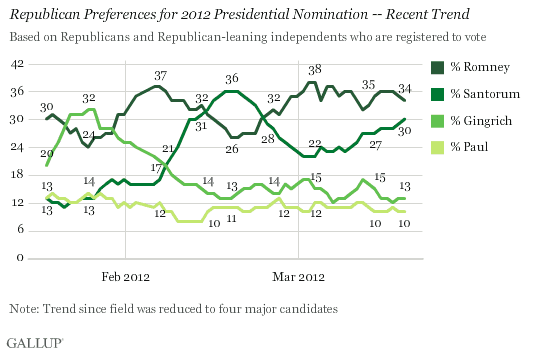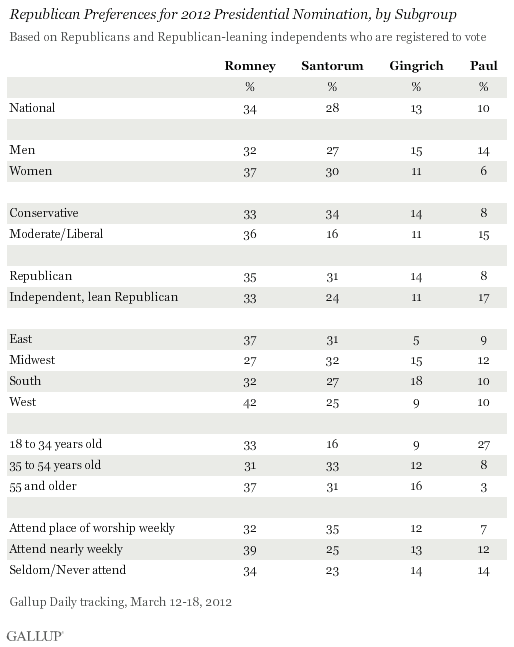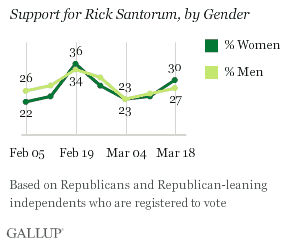PRINCETON, NJ -- Mitt Romney's lead among Republican registered voters for the GOP presidential nomination has narrowed since early March, to the point that he now has only a slight advantage (34% to 30%) over Rick Santorum. The same Gallup Daily tracking, conducted March 15-19, shows Newt Gingrich edging out Ron Paul for a distant third place, 13% to 10%.

Romney's support briefly surged to 38% in early March -- his highest share of the Republican vote to date -- after his victories in the Feb. 28 Michigan and Arizona primaries. However, in Gallup Daily tracking conducted since the mixed-result Super Tuesday primaries on March 6, Romney's support has varied between 32% and 36%, with Santorum's between 25% and 30%.
The March 15-19 Gallup Daily tracking results, based on 1,157 Republicans and Republican-leaning independents who are registered to vote, are similar to Gallup's March 12-18 weekly average in which Romney was favored by 34% and Santorum by 28%. According to that larger compilation of data, Romney holds slight leads over Santorum among men, women, residents of the East and the South, and Republicans aged 55 and older. Romney has more substantial leads among moderate/liberal Republicans, those living in the West, voters aged 18 to 34, and those who attend church or another place of worship less than weekly.
Santorum ties Romney among conservatives, voters aged 35 to 54, and those who attend a place of worship weekly. He leads Romney slightly in the Midwest. This is quite different from a month ago when Santorum had sizable leads in the Midwest and among the more conservative and religious segments of Republican voters. At that time, Santorum led Romney among all Republicans, nationally, by eight percentage points, coming off his wins in the Minnesota, Colorado, and Missouri Republican contests on Feb. 7.

While more Republican women back Romney than Santorum, female support for Santorum is holding up despite widespread media discussion of his conservative positions on contraception and other women's issues.
More importantly, Republican women's support for Santorum has moved in tandem with Republican men's support, as was seen in last week's Gallup Daily tracking results.


Bottom Line
National Republican preferences for the 2012 GOP nomination have been largely steady in the relatively quiet period following the March 6 Super Tuesday primaries, with Romney consistently ahead, but that could change if the polls in Illinois accurately predict Romney capturing a big win tonight. Going into the Illinois primary, however, he has a very tenuous lead over Santorum nationally and continues to struggle winning the support of conservatives and Republicans in the Midwest.
Track every angle of the presidential race on Gallup.com's Election 2012 page.
Survey Methods
Results are based on telephone interviews conducted as part of the Gallup Daily tracking March 15-19, 2012, with a random sample of 1,157 Republicans and Republican-leaning independents, aged 18 and older, living in all 50 U.S. states and the District of Columbia.
For results based on the total sample of Republican registered voters, one can say with 95% confidence that the maximum margin of sampling error is ±4 percentage points.
Interviews are conducted with respondents on landline telephones and cellular phones, with interviews conducted in Spanish for respondents who are primarily Spanish-speaking. Each sample includes a minimum quota of 400 cell phone respondents and 600 landline respondents per 1,000 national adults, with additional minimum quotas among landline respondents by region. Landline telephone numbers are chosen at random among listed telephone numbers. Cell phone numbers are selected using random-digit-dial methods. Landline respondents are chosen at random within each household on the basis of which member had the most recent birthday.
Samples are weighted by gender, age, race, Hispanic ethnicity, education, region, adults in the household, and phone status (cell phone only/landline only/both, cell phone mostly, and having an unlisted landline number). Demographic weighting targets are based on the March 2011 Current Population Survey figures for the aged 18 and older non-institutionalized population living in U.S. telephone households. All reported margins of sampling error include the computed design effects for weighting and sample design.
In addition to sampling error, question wording and practical difficulties in conducting surveys can introduce error or bias into the findings of public opinion polls.
For more details on Gallup's polling methodology, visit www.gallup.com.
